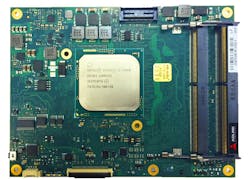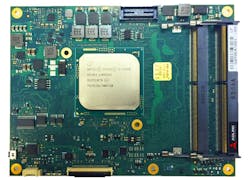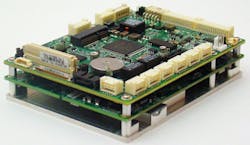COM Express Modules Handle 10 G Ethernet
This file type includes high resolution graphics and schematics when applicable.
PICMG’s COM Express standard has garnered quite a following. The standard encompasses a range of board sizes and features: Basic size module is 125 mm by 99 mm, while the Mini is only 84 mm by 55 mm. In between is a 95 mm by 95 mm Compact and a larger 110 mm by 155 mm Extended version.
The COM approach allows simplified carrier board designs to host different modules depending upon system requirements. It also provides an upgrade path as newer modules are released. Carrier boards are for the most part significantly easier to design and less expensive than the modules that have the high-performance parts, such as the processor and memory. The COM Express interface exposes most interfaces, with the exception of memory.
COM Express modules have connectors for a carrier board on one side and often have sockets for memory, as the connectors to the base board are normally reserved for interface signals including Ethernet networking and PCI Express. The COM Express Type indicates the connector and interfaces provided. Common types include Type 2, 6, 7, and 10.
ADLINK Technology’s Express-BD7 (Fig. 1) is a Type 7 COM Express module that supports x16 PCI Express Gen 3, eight x1 PCI Express Gen 2, and two 10 Gbit/s Ethernet interfaces with NC-SI support. There is an addition gigabit Ethernet port, two SATA 6 Gbit/s ports, and four USB 3.0/2.0 ports. The module has an Intel Xeon D with up to 16 cores and up to 32 Gbytes of DDR4 with ECC in a pair of SODIMM sockets. The system supports ADLINK’s Smart Embedded Management Agent (SEMA).
The Express-BD7 is one of the larger COM Express form factors, but it is still possible to fit 10 into a 1U box. Of course, it could use its own switch since it would have 20 10 Gigabit Ethernet connections and 10 Gigabit Ethernet connections.
Most applications will likely use a single Express-BD7. The 65 W TDP per module minimizes cooling requirements. Note that this module does not provide video output as it is designed as a compute and networking solution.
COM Express modules can be used with custom carrier boards, but they have also been useful in providing standard platforms. This provides vendors with a module solution while reducing the number of systems.
Diamond Systems uses a COM Express module in its Vega EmbeddedXpress (EMX) form-factor system (Fig. 2). The Vega can also be found inside Diamond Systems’ rugged Raptor-Vega enclosure system.
The top Vega layer is actually the carrier board with the exposed peripheral interfaces. The carrier also has a Mini-PCIe socket for expansion. In addition, the socket supports mSATA storage. There is an EMX bus connector for additional board expansion.
The bottom of the stack is a heat spreader for the 95 mm by 125 mm COM Express board in the middle. The COM Express boards have a 1.7 GHz Intel Core i7-3517UE or a 2.1 GHz Intel Core i7-3612QE processor. The have up to 8 Gbytes of DDR3 SDRAM in an SO-DIMM package. There are also two Gigabit Ethernet ports, a SATA port, four USB 2.0 ports, and four RS-232/422/485 serial ports, plus VGA/LVDS video outputs and HD audio support. The system also sports 16-bit ADC and DAC, digital I/O, and counter/timers. It runs Windows and Linux.
COM Express is only one of many computer-on-module (COM) form factors. Another common COM form factor is SMARC. SMARC comes in a full-size 82 mm by 80 mm version and a short 80s mm by 50 mm module.
COM’s popularity continues to increase among designers and developers. It provides flexible scaling options while reducing custom design costs. Smaller modules even work in portable applications.
This file type includes high resolution graphics and schematics when applicable.
About the Author
William G. Wong
Senior Content Director - Electronic Design and Microwaves & RF
I am Editor of Electronic Design focusing on embedded, software, and systems. As Senior Content Director, I also manage Microwaves & RF and I work with a great team of editors to provide engineers, programmers, developers and technical managers with interesting and useful articles and videos on a regular basis. Check out our free newsletters to see the latest content.
You can send press releases for new products for possible coverage on the website. I am also interested in receiving contributed articles for publishing on our website. Use our template and send to me along with a signed release form.
Check out my blog, AltEmbedded on Electronic Design, as well as his latest articles on this site that are listed below.
You can visit my social media via these links:
- AltEmbedded on Electronic Design
- Bill Wong on Facebook
- @AltEmbedded on Twitter
- Bill Wong on LinkedIn
I earned a Bachelor of Electrical Engineering at the Georgia Institute of Technology and a Masters in Computer Science from Rutgers University. I still do a bit of programming using everything from C and C++ to Rust and Ada/SPARK. I do a bit of PHP programming for Drupal websites. I have posted a few Drupal modules.
I still get a hand on software and electronic hardware. Some of this can be found on our Kit Close-Up video series. You can also see me on many of our TechXchange Talk videos. I am interested in a range of projects from robotics to artificial intelligence.





